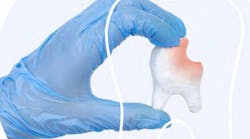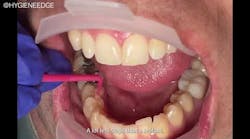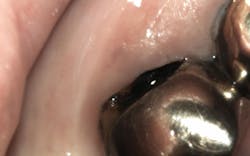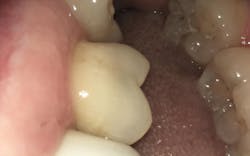SDF application in the hands of a dental hygienist: 4 cases
Listen to the article on our podcast!
Patients seen in the dental hygiene chair each have individual oral health needs. Some of these needs are not as straightforward, therefore requiring additional critical thinking skills to develop treatment plans. Silver diamine fluoride (SDF) offers solutions to some of those “sticky” situations.
Placing SDF in the hygiene operatory may serve as a valuable consideration for any dental practice. In this article, we will review SDF and its various uses and applications. With a better understanding of the benefits, dental hygienists may incorporate SDF into routine care.
What is SDF and how can it help?
SDF is a blue-tinted, odorless liquid that is used to help arrest decay and treat hypersensitivity. SDF has a pH of 10–13 and is composed of 25% silver, 5% fluoride, and 8% ammonia.1 The antimicrobial element, silver, kills decay-causing bacteria and arrests growth, while fluoride remineralizes the tooth structure. Unlike decayed lesions, sound tooth structure will not stain.
SDF is also an effective treatment for root surface hypersensitivity. However, use caution or avoid using SDF on hypersensitive anterior teeth due to possible staining. The opportunities for SDF application are plentiful, with many surfaces located away from the smile line.
Clinical tips
The simple steps of SDF application can easily be incorporated into the routine hygiene appointment. SDF is easily applied to teeth and can even reach interproximal areas. When working with SDF, first isolate the tooth (or teeth) with cotton rolls and dry. Next, apply SDF with a bendable microapplicator for one minute to wet the lesion(s). Interproximal areas can be reached with tufted floss by first inserting the floss between the teeth and then transferring the SDF liquid to the tufted floss with a microapplicator. The tufted floss will absorb the SDF and reach the interproximal areas. A fluoride varnish application completes treatment to protect the rest of the teeth and mask the taste of the SDF.
To prevent staining throughout the oral cavity, carefully apply fluoride varnish on all other teeth prior to the SDF-treated teeth. Any soft tissue touched by SDF will temporarily stain a henna-like brown color. SDF causes permanent staining when contacting countertops or clothing. Educate the dental team to use caution and immediately discard used applicators to help eliminate unwanted equipment staining.
Insurance and delegated application
Delegated application, insurance coverage, and coding information vary among states. Refer to individual state rules for further understanding of the dental hygiene scope of practice for SDF application and level of supervision.
SDF is approved by the FDA to desensitize teeth, but it is commonly used off-label for arresting caries.1 The dental codes for applying SDF are:
- D1354: Interim caries arresting medication application
- D9910: Application of desensitizing medicament
- D1355: Caries preventive medicament application
- D9110: Palliative treatment of dental pain
Not all insurance covers SDF treatment. It is advisable to discuss the cost-effectiveness of SDF treatment with patients, parents, or guardians as an easy and painless way to help stop decay when restorative treatment cannot be completed immediately and/or to desensitize a tooth. Additional conversation regarding insurance coverage and stain is advised—in addition to verbal or written consent for SDF application.
SDF benefits patients of all ages and backgrounds as it can prevent the progression of decay and preserve healthy tooth structure. A careful clinical assessment and thorough review of a patient’s health history can identify high caries risk. Patients who report one or more of the following are considered high caries risk and are candidates for SDF:
- Consuming sugar frequently
- Experiencing dry mouth/xerostomia
- Taking anticholinergic medications
- Suffering from Sjögren’s syndrome
- Undergoing cancer treatment/therapy
As a dental hygienist, consider SDF application for high-caries-risk patients as an immediate treatment to arrest decay and preserve tooth structure. The following cases illustrate SDF applications.
Case A: Pediatric patients
Some treatment plans—especially for younger patients—require a conservative approach. SDF Modified Atraumatic Restorative Treatment (SMART) is a restorative method that uses hand instruments or occasionally slow-speed handpieces to remove caries, followed by SDF treatment and glass ionomer cement.2 SMART offers an alternative to the traditional surgical approach, helping avoid sedation, anesthesia, and drilling with potential concerns of time, safety, and behavior.
The dental provider and hygienist can work together to complement each other’s scope of practice in one or two appointments. Dental hygienists have an ideal role in integrating SDF applications into the hygiene appointment as teeth are free of debris after a dental prophylaxis and are ready for treatment. If the restoration cannot be performed during the same appointment, SDF buys time and/or improves safety for the patient and dental team. Follow-up care with SDF treatment may be added to a three- to six-month recall appointment for additional application.
Case B: Deep decay under a crown
This patient was seen in the hygiene chair. The patient presented with deep lingual decay under the crown of tooth no. 18 (figure 1). The provider implemented hand excavation with a spoon excavator, and then the hygienist isolated the tooth and applied SDF for one minute, followed by fluoride treatment. When the patient returned to the clinic for a filling, the arrested black stained decay was removed, leaving sound structure underneath. A self-cure glass ionomer composite was placed.
Case C: Decay in furcation
A cancer survivor presented with a dry mouth and high plaque index, resulting in rampant carious lesions around several cervical areas of his dentition. Increasing the patient recall to a three-month appointment with extensive oral hygiene instruction was advised. SDF was applied and reapplied during recalls to areas with limited access, such as furcations (figure 2).
Case D: Desensitizing
The patient stated she felt cold sensitivity occurring on the upper left between nos. 14 and 15. Slight gum recession was noted on the buccal surface of no. 15 (figure 3). After a prophy was completed, the tooth was isolated with a cotton roll and tufted floss was placed interproximally on 14/15. SDF was brushed on the tooth for one minute along the buccal gumline of no. 15 and interproximally. No staining occurred. The patient stated she felt instant relief while drinking cold water. The code for tooth sensitivity is D9910: Application of desensitizing medicament per visit.
These images and patient treatment options help explain how and when dental hygienists can use SDF to complement their dental provider’s diagnosis and treatment. SDF can help arrest decay and possibly uncomplicate complicated procedures. Dental hygienists can be resourceful to free up their provider’s time by completing SDF treatment. SDF is a useful tool to include as a preventive method in the hands of dental hygienists.
Editor's note: This article appeared in the July 2024 print edition of RDH magazine. Dental hygienists in North America are eligible for a complimentary print subscription. Sign up here.
References
- Natarajan D. Silver Modified Atraumatic Restorative Technique: a way toward “SMART” pediatric dentistry during the COVID-19 pandemic. Front Dent. 2022;19:12. doi:10.18502/fid.v19i12.9215
- Frencken JE, Leal SC. The correct use of the ART approach. J Appl Oral Sci. 2010;18(1):1-4. doi:10.1590/s1678-77572010000100002
About the Author

Sheri Solseng Trif, MSADT, BSDH, RDH
Sheri Solseng Trif, MSADT, BSDH, RDH, is dual licensed with a BS in dental hygiene and an MS in advanced dental therapy. She works as an advanced dental therapist (like a nurse practitioner but in the dental field) in a critical access area of rural Minnesota. Sheri is an active member and past president of the Minnesota Dental Therapy Association. Her book, A Fun Day at the Dental Clinic: A Little Patient’s First Filling, is available on Amazon.
Updated May 30, 2024





